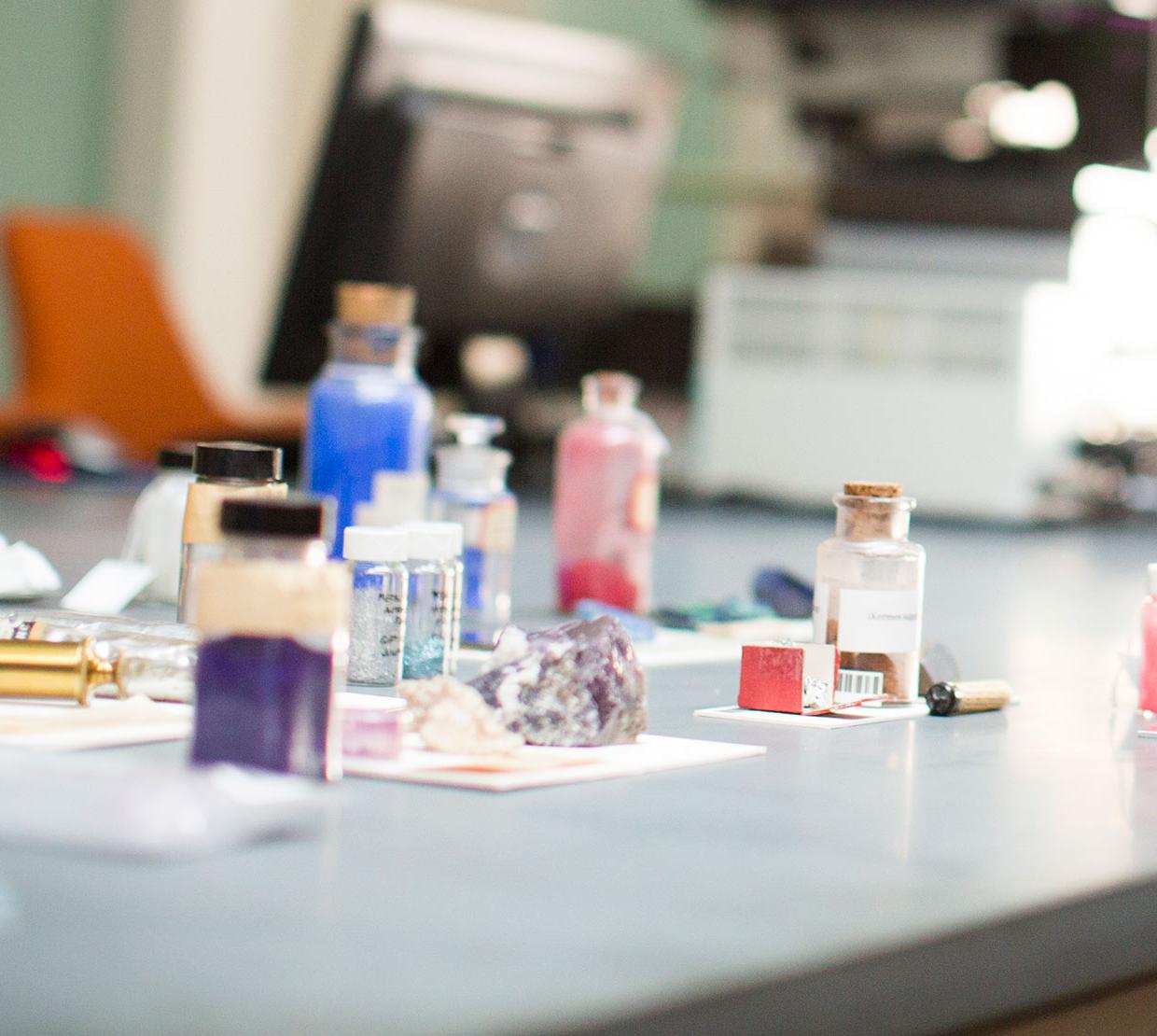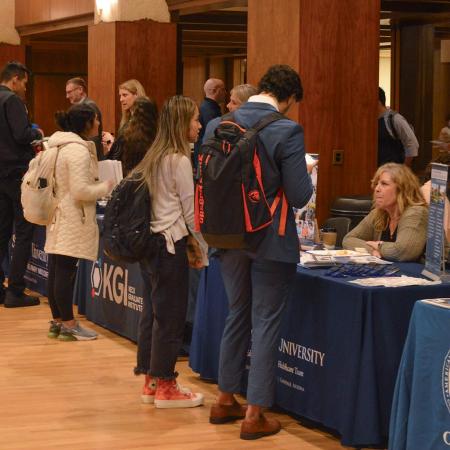Watch the video of Crayola's surprise announcement of a new blue crayon inspired by OSU's YInMn blue pigment.
A new color pigment can seize the world’s attention like very few discoveries or inventions can. Chemistry professor Mas Subramanian’s 2009 discovery of a durable, non-toxic and intensely brilliant new blue pigment, called YInMn blue, has awakened the public’s interest in the science of colors, inspired works of art, sparked innovation in the paint industry, and made history as the first new inorganic blue pigment in more than 200 years.
The College of Science hosted “The Colorful World of Pigments,” a series of events on May 5, 2017, that celebrated the immensely fertile meeting point of science, art, color and cultural trends in Subramanian’s groundbreaking pigment discovery.
This public event was part of SPARK, Oregon State’s yearlong celebration of the intersection of the arts and science.
The signature feature of the event was a stimulating discussion by a panel of color experts ranging from the fields of science and chemistry, color theory and design to history and industry.
LeeAnn Garrison, Director of OSU’s School of Arts and Communication and a color theorist, moderated the event, which featured the following speakers:
- Mas Subramanian, the Milton Harris Chair Professor of Materials Science at OSU who discovered YInMn blue, researches new materials and processes that impact energy, electronics and the environment. He has been issued 55 U.S. patents. In 2016, Dr. Subramanian was named Oregon Scientist of the Year by the Oregon Academy of Sciences. He will share the unexpected yet happy accident of discovering YInMn blue.
- Christopher Manning, The Shepherd Color Company, is trained in color chemistry and has over 40 years of international experience in the coatings, textile and pigments industries. He will offer perspectives on the transformation of color from pigment to practical applications.
- Narayan Khandekar, Harvard Art Museums' Director of the Straus Center for Conservation and Technical Studies, home to the 2,500-specimen Forbes Pigment Collection, an extensive inventory of the world’s pigments. A conservation scientist specializing in the scientific analysis of paintings and painted surfaces, Dr. Khandekar addressed the importance and role of pigments throughout history.
- Smith Holland, Crayola, CEO and President, discussed how color brings “Colorful Wings to Invisible Things” and how the power of color fuels imaginative thinkers who grow up to be inspired adults
- Leena Vadaketh, Crayola, VP of Research and Development explained the importance of color in kid-inspired products
- Kim Kenney, Nike's Senior Director of Color Design and OSU alumna, offered views on color design in performance-based products.
- Emily Henderson, HGTV Design Star and prop stylist originally from Portland, shared ideas about the power of color and design.
- Special guests with a surprise announcement!
- Lee Ann Garrison, is Director of OSU’s School of Arts & Communication and Panel Moderator.
A blue, blue day
- 8 – 9:00 a.m. COFFEE and light breakfast
- 8 a.m. to noon, ART EXHIBIT, LaSells Stewart Center. The exhibit features works from students and professionals who use YInMn blue.
- 9 -10:30 a.m., PANEL DISCUSSION followed by Q&A, culminating in a sensational announcement by a surprise guest you wouldn’t want to miss.
- 10:30 a.m. to 12:30 p.m., COMMUNITY WALL MURAL ACTIVITY, Giustina Gallery in LaSells Stewart Center. Kids of all ages are welcome to participate in this creative activity.
- 11 a.m., 1:30 p.m. and 3:00 p.m., LAB TOURS. Dr. Subramanian will lead tours of the lab where YInMn blue was discovered. Space is limited and available on a first-come, first-served basis. Sign up via email: science@oregonstate.edu.
YInMn blue— so named for its composition from the elements Yttrium, Indium, Manganese and Oxygen—first discovered seven years ago, continues to make news worldwide not least because the video of the discovery went viral last summer following a Tech Insider online story and video. The story has reverberated across the Internet with more than 12 million shares at last count. News of YinMn has appeared everywhere from Cosmopolitan, New York Magazine, TIME magazine and the Huffington Post to The Daily Mail, India Today and BBC/Mundo among others. NPR devoted an in-depth feature on the blue pigment.
The now-famous blue was elevated to a sanctified place beside other color pigment discoveries throughout history when it made its prestigious debut in the Forbes Pigment Collection at the Harvard Art Museums.
Dr. Khandekar of The Forbes Pigments Collection discussed the importance and role of pigments throughout history. In a recent interview with NPR, he extolled the artistic possibilities contained in Subramanian’s discovery and how the world could discover the beauty and significance of YInMn through art. “When you put pigments in art, people stop and pay attention to it.”
As with any new pigment discovery in history, Subramanian’s vibrant blue has captivated artists. History has many precedents for the relationship between blue pigments, which due to their rarity were once prized over gold, and art. Royal blue or the ultramarine pigment derived from the lapis lazuli stone was used by Michelangelo in his frescoes in the Sistine Chapel, and Prussian blue, discovered in 1704, transformed the art world of the mid-19th century. YInMn blue opens new creative possibilities for art once again.
Subramanian gets frequent requests for the blue pigment from artists in Oregon and beyond as well as interview requests from people in art and fashion seeking to understand more about YInMn. Stunning art featuring the vivid blue pigment are accumulating. Oregon State applied visual arts alumna Madelaine Corbin, began using YInMn blue in her art work during an internship in Subramanian’s laboratory, her first foray into the world of chemistry.
YImMn blue is also inspiring innovation in the commercial sphere. It is being mass-produced by the Shepherd Color Company due to its extraordinary heat-reflecting and environmentally friendly properties. After putting YInMn blue through a series of rigorous tests, the color company determined that the superior pigment could be put to use “in a variety of external applications by reducing surface temperatures, cooling costs and energy consumption.”
The journey of YInMn from pigment to market will be shared by Christopher Manning from the Shepherd Color Company, who will shed light on why this pigment is so special and how it fits into the global high-performance pigment market and its specific industry applications.
Kim Kenney, senior director of color design at Nike, discussed the psychology of color in sports and pop culture, how that is influenced by the fashion industry and has an impact on creative thinking, the economy and product development/durability.
HGTV host and celebrity designer Emily Henderson delved into the power of color and design. The Oregon native has a strong commitment to vintage-inspired home styles and design for everyone and espouses the philosophy “Perfection is boring. Let’s get weird.”
The event was capped off by a Crayola's surprise announcement of a new blue crayon inspired by OSU's YInMn blue pigment to debut this fall. Crayola CEO Smith Holland also announced a national contest to name the blue crayon.
“I am flabbergasted by the impact of YInMn blue. This story of blue never fades. It gets a new sheen to it every time,” said Subramanian. “In the end, I feel the most valuable thing is I can explain to the general public why science is so important. It changes the world we live in.”
Sastry G. Pantula, dean of OSU's College of Science, had high praise for Subramanian.
“I am overjoyed by this event to recognize and honor Mas's iconic discovery of a new color pigment. Both his discovery and this event exemplify the intellectually and creatively rich environment in which our students learn and discover science."
A blue out of the blue
Have you ever thought that the iridescent blue of peacock plumage is one of the most glorious colors in nature? As it turns out, the peacock’s blue is not a result of pigment, but rather a beautiful illusion caused by the reflection and absorption of light by feathers.
Nature, Subramanian likes to say, rarely produces a blue pigment. Neither does the lab for that matter. The last blue pigment, cobalt blue, was discovered in 1802 and its toxic nature has long made it unpopular in industry. Little wonder then that Subramanian’s blue pigment is a major breakthrough and has turned into a global sensation.
“People have been looking for a good, durable blue color for a couple of centuries,” said Subramanian in a NPR interview.
Subramanian, a Milton-Harris Professor of Materials Science, accidentally discovered the previously unknown blue pigment in 2009 while working with students in his lab to manufacture new magnetic materials that could be used in computer memory.
Subramanian instructed a graduate student to make a series of compounds by combining oxides of the elements Yttrium, Indium and Manganese (white, yellow and black in color respectively) and heating the mixture to about 2000 degrees Fahrenheit. When the resulting powder was taken out of the furnace, they were struck by the anomalous vivid blue color.
“I was shocked when I saw the sample. If you had asked me the color of the sample, based on the elements that went in I would have predicted gray or brown,” said Subramanian.
The chemical material absorbed red and green wavelengths and reflected blue wavelengths in such a way that it came out a brilliant blue shade. The unique crystal structure of YInMn lends it an intense blue color and prevents the color from fading when exposed to oil or water.
There is a very high benchmark for a pigment discovery to endure and be counted as a success. While scientists have made blue compounds since 1802, none could be termed a pigment, a material that absorbs wavelengths of light and reflects certain colors. Subramanian’s pigment possesses all the desirable properties that make it apt for industrial applications and for creating art: stability, durability, compatibility with oil and water, heat reflectivity and the ability to absorb ultraviolet radiation.
Subramanian joins the club of illustrious inventors who have enjoyed the precious thrill of unexpected discovery. Many scientific discoveries, including major drugs of the 20th century, the microwave oven, and pigments like YImMn and Prussian blue, have been the result of serendipity and chance, when a scientist stumbled upon a discovery and recognized its potential.
“I am often asked how it felt to see YInMn blue for the first time. It is hard to capture in words. I tell my students you have to experience the discovery,” remarks Subramanian.
Subramanian often tells his students that in research, the journey is more important than the destination. “You may start seeing things on the way that are more interesting than the destination.”
Along with his research team, Subramanian has moved on to the invention of new pigments, tuning compounds by replacing elements. He and his team created an orange pigment by substituting manganese with iron. They also made a green pigment by replacing manganese with copper and a purple one by adding zinc and titanium.
Always the material chemist, Subramanian inspires his students by hinting how new scientific ideas can evolve from working on unrelated projects, including the next big thing in materials science for which the world awaits with bated breath.
“I tell them, now we are working on finding a red pigment. But we could end up discovering a room-temperature superconductor.”




